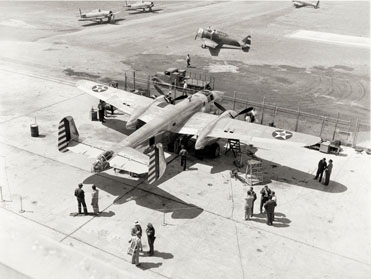B-25-NA SN 40-2165
History
On September 5, 1939, North American General Order NA-62 was signed. The order authorized the construction of 184 bombers and one test airframe. The B-25-NA 40-2165 was the test airframe. The basic design of the B-25 would utilize many of the features seen in the earlier NA-40. Tricycle landing gear, twin vertical tails with similar shape, root airfoil, identical engines and cowling shapes, constant dihedral and underhung nacelles were all drawn from the NA-40. The B-25 would also include Hamilton propellers. Side by side pilot seating, greater speed, range and payload capacity differentiated the two aircraft. The wing was moved to a shoulder position and the gross weight was increased by 8,000 pounds. The aircraft would be powered by Wright R-2600 engines.
Production of the first aircraft proceeded and by summer of 1940, 40-2165 was entering final assembly. During taxi testing, a problem with the design of the nose wheel shimmy damper resulted in a nose gear failure damaging the aircraft. The aircraft was repaired and the shimmy damper re-designed. On August 19, 1940, test pilot Vance Breese and North American test engineer Roy Ferren flew 40-2165 for the first time. Ferren reported a severe roll-yaw condition existed. North American proceeded to test 4 other vertical stabilizer shapes before solving this problem. In an early flight test, a fuel line rupture caused a small explosion to blow the access panel off the leading edge of the right wing. The force of the explosion also continued inside the plane and damaged the windshield and instrument panel. The resulting aerodynamic issues forced a wheels-up landing in the grass between the landing strips at Mines Field. Again, the plane was repaired and testing continued.
The B-25 would be a bomber, and testing with the state-of-the-art Norden bombsight commenced. Captain Frank Cook flew the plane for the Air Corps to test general handling characteristics. He determined the plane had a "Dutch roll" characteristic that he considered incompatible with bomb runs. The solution to this problem was to negate the dihedral of the outer wing panels. After this final adjustment, the flight characteristics of the B-25 were so nearly optimal that the configuration would remain unchanged during the entire production run.
The test airframe 40-2165, would remain with North American and was used for testing until November of 1942. At this time, the aircraft was modified for use as a company transport. All military equipment was removed. Five seats were installed in the rear fuselage and two seats were installed forward of the bomb bay behind the flight deck. Windows in the rear fuselage, a desk and intercom system were also installed. The greenhouse nose was faired over and a set of flares replaced the tail gun position. The bomb bay was converted for luggage storage and a bunk installed in the crawl space above. In July of 1943, she spent 2 weeks at the Fairfax plant. 40-2165 would be used as a transport until January 8, 1945 when she was damaged beyond repair in a crash landing in an open field caused by a hydraulic system failure. She was then disassembled and scrapped.
- Model: B-25-NA
- Serial Number: 40-2165
- NAA Mfg. Number: 62-2834
- FAA Registration: Never registered
- Mfg. Plant: Inglewood, California
- Completion Date: August 6, 1940
- Delivery Date: n/a
- Status: crashed January 8, 1945
- Owner: North American Aviation
- Location: scrapped
- Website: n/a
- Notable info: The first B-25-NA produced.
This page represents the most current information we have on this aircraft. The information above was last updated 12/2016. Our goal is to have the most current and correct information possible. If you have any information about this aircraft not listed here or see anything posted in error, please contact the B-25 History Project so we may update our records.








